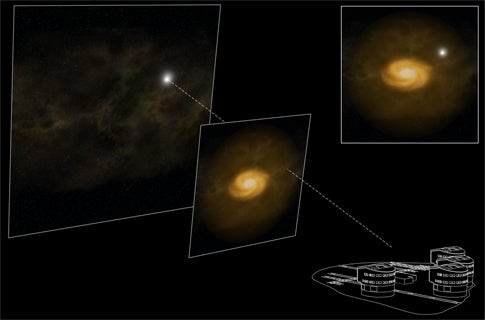Astronomers using ESO’s Very Large Telescope have discovered in a single pass about a dozen otherwise invisible galaxies halfway across the universe. The discovery, based on a technique that exploits a first-class instrument, represents a major breakthrough in the field of galaxy ‘hunting’.
The team of astronomers led by Nicolas Bouche has used quasars to find these galaxies. Quasars are very distant objects of extreme brilliance, which are used as cosmic beacons that reveal galaxies lying between the quasar and us. The galaxy’s presence is revealed by a ‘dip’ in the spectrum of the quasar — caused by the absorption of light at a specific wavelength.
The team used huge catalogues of quasars, the so-called SDSS and 2QZ catalogues, to select quasars with dips. The next step was then to observe the patches of the sky around these quasars in search for the foreground galaxies from the time the Universe was about 6 billion years old, almost half of its current age.
“The difficulty in actually spotting and seeing these galaxies stems from the fact that the glare of the quasar is too strong compared to the dim light of the galaxy,” says Bouche.
This is where observations taken with SINFONI on ESO’s VLT made the difference. SINFONI is an infrared ‘integral field spectrometer’ that simultaneously delivers very sharp images and highly resolved color information (spectra) of an object on the sky.
With this special technique, which untangles the light of the galaxy from the quasar light, the team detected 14 galaxies out of the 20 pre-selected quasar patches of sky, a hefty 70% success rate.
“This high detection rate alone is a very exciting result,” says Bouche. “But, these are not just ordinary galaxies: they are most notable ones, actively forming a lot of new stars and qualifying as ‘starburst galaxies’.”
“We discovered that the galaxies located near the quasar sightlines are forming stars at a prodigious rate, equivalent to 20 suns per year,” adds team member Celine Peroux.
These findings represent a big leap forward in the field, setting the stage for a very promising era of galaxy ‘hunting’.
The astronomers now plan to use SINFONI to study in more detail each of these galaxies, by measuring their internal motions.










